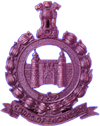Indian Engineers
| Indian Army Corps of Engineers | |
|---|---|

The logo of the Corps of Engineers
|
|
| Active | 1777-Present |
| Country |
|
| Branch |
|
| Garrison/HQ | New Delhi, India |
| Motto(s) | Sarvatra (Everywhere in Hindi) |
| Colors | Maroon and blue |
| Engagements |
Second Anglo-Afghan War First World War Second World War Burma Campaign Sino-Indian War Indo-Pak War-1947 Indo-Pak War-1965 Indo-Pak War-1971 Kargil War |
| Commanders | |
| Engineer-in-Chief | Lt Gen Sanjiv Talwar, AVSM |
| Notable commanders |
Lt Gen Premindra Singh Bhagat |
The Indian Army Corps of Engineers has a long history dating back to the mid-18th century. The earliest existing subunit of the Corps (18 Field Company) dates back to 1777 while the Corps officially recognises its birth as 1780 when the senior most group of the Corps, the Madras Sappers were raised.
The Corps consists of three groups of combat engineers, namely the Madras Sappers, the Bengal Sappers and the Bombay Sappers. A group is roughly analogous to a regiment of Indian infantry, each group consisting of a number of engineer regiments. The engineer regiment is the basic combat engineer unit, analogous to an infantry battalion.
Besides the combat engineers, the Corps mans and operates major engineering organisations such as the Military Engineering Service (MES), the Border Roads Organisation (BRO), the Married Accommodation Project and the Survey of India.
The Corps of Engineers is one of the oldest arms of the Indian Army. The origin of the Corps dates back to 1780 when the two regular pioneer companies were raised in the Madras Presidency Army. Subsequently, the Group of Madras, Bengal and Bombay Sappers were formed in their respective presidencies. These Groups came together when the British Indian Army was formed after 1857 and were later merged on 18 November 1932 to form the Corps of Indian Engineers. Engineer Groups initially consisted of field companies (a sub-unit organisation that exists to this day).
Till 1911, the Sappers also had the duty of passing battlefield messages. Between 1911 and 1920, they handed this task to a batch of their own kinsmen who then formed the Corps of Signals. The Sappers also contributed the first batch of airmen when the Indian Air Force was raised in 1932. From 1942-1945 officers of the Indian Railways were recruited into this Corps to participate in Britain's Burma Campaign.
...
Wikipedia
